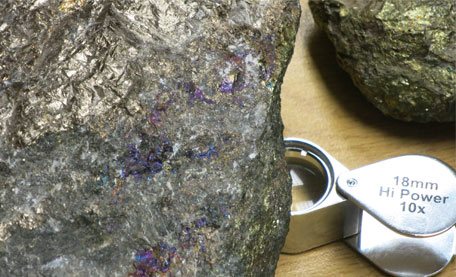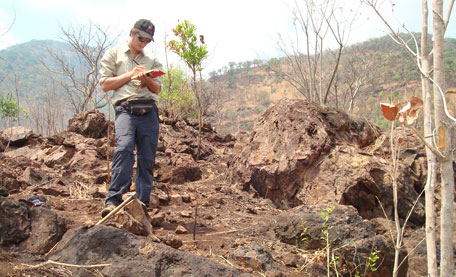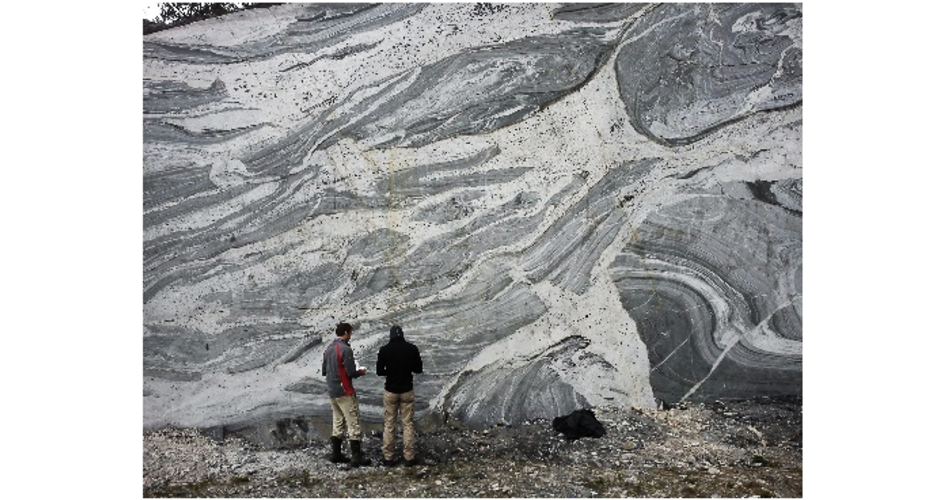Ore deposits and critical metals
We work to promote sustainable development through future supplies of raw materials. We research the fundamental geological processes that form ore deposits and apply mineralogical studies to more efficient and environmentally friendly mineral processing and metals stewardship. We work particularly on:
- Critical metals: rare earths (REE), platinum group elements, niobium, tantalum, indium, tungsten, lithium.
- Granites and metamorphic rocks in South West England and associated ore deposits.
- Processes in large magma chambers such as the Skaergaard intrusion, Greenland.
- The Earth’s most unusual volcanoes that erupt carbonate (‘carbonatite’) magmas.
We have a Critical Metals Alliance with the British Geological Survey.
Group members

Critical Metals Alliance
In 2011, Camborne School of Mines and the British Geological Survey (BGS) joined forces to improve research capability in critical metals. The collaboration builds on the knowledge and facilities of each to improve understanding of critical metals ore formation. At the heart of the alliance is BGS Lecturer in Critical and Green Technology Metals Dr Kathryn Moore, leading research into carbonatites and alkaline rock petrogenesis.
The Critical Metals Alliance members are:
- Mr Andrew Bloodworth - Science Director for Minerals and Waste
- Dr Kathryn Goodenough - Principal Geologist
- Gus Gunn - Economic Geologist
- Richard Shaw - Economic Geologist
PhD students
- Callum Scott
- Eimear Deady
- Dora Kavecsanszki
- Jordan Lindsay
- Charlie Compton-Jones
- Lawrence Carter
- Fei Zhang
- Michael Musialike
Projects
Critical metals are essential in various industrial applications, often in new and green technologies, difficult to substitute and for which the main supply is restricted to just one or two countries. Their supply is thus vulnerable to disruption. The European Union has defined 14 critical materials. Amongst these, we have particular expertise on rare earths, platinum group elements, niobium, tantalum, indium, and tungsten. The University is working in collaboration with the British Geological Survey, to improve our knowledge of how these deposits form and to work on new ways to extract them from waste materials and as by-products.

The rare earth elements include the lanthanide group of the periodic table, and yttrium. They are principally used in high-tech applications, such as high-strength permanent magnets, and are considered as ‘critical metals’ (i.e. an irreplaceable metal with a high supply risk) due to concerns regarding China’s near-dominant control of the market (more than 90 per cent).
At Camborne School of Mines, we are working with industry to understand the geology of new rare earth deposits, new mineral processing techniques and the social and environmental implications of rare-earth mining. CSM are involved in, or leading, the research grants SoS-RARE project, and HiTechAlkCarb.

.jpg)
New project to find Europe’s green technology metals
A new four-year project ‘GREENPEG’ has received a grant of €8.3 million from the European Union’s Horizon 2020 research and innovation programme to develop new techniques to explore for pegmatite rocks containing lithium and other green technology metals.
The consortium consists of 13 partners from 8 European countries, including universities and exploration and mining companies. The University of Exeter team, which will receive nearly €780k, is led by Ben Williamson with Frances Wall, Camborne School of Mines and Xiaoyu Yan, Engineering, supported by post-doctoral researchers Kate Smith and Rob Pell.
Professor Ben Williamson, Camborne School of Mines, University of Exeter, said: “This is an exciting project and an excellent opportunity to continue state of the art research and innovation with our European colleagues. We will be contributing our geological knowledge of pegmatites, and our environmental expertise, particularly in the technique of life cycle assessment“.
Pegmatite-hosted deposits can be particularly rich in technology metals, such as lithium, but are often small and difficult to find using conventional exploration methods. Europe contains an abundance of pegmatites but very few are currently economic to mine.
The GREENPEG project will develop exploration toolsets for European pegmatite ore deposits. These will be specific to either lithium-caesium-tantalum-, or niobium-yttrium-fluorine-bearing pegmatites, which may also carry high-purity quartz. These raw materials are used in the manufacture of a wide range of green energy devices such as Li-ion batteries for electric cars, solar panels and wind turbines.
It is critical that Europe can source its own supplies of these commodities to meet ambitious 2030 energy and climate targets. The toolsets will be developed at three green and brownfield exploration and mining case study sites at Wolfsberg (Austria), South Leinster (Ireland) and Tysfjord (Norway) where industry partners can immediately benefit from the research.
GREENPEG will integrate its new products and services into associated businesses, attract investment into the European raw materials sector and increase the competitiveness of European green technology metals exploration companies.
For more information see: www.greenpeg.eu

Publications and presentations
View the slides from PhD student Robert Pell's presentation: "Criticality as a life cycle impact indicator for rare earth elements".
In Press
- Sajid, M, Andersen, JCØ, Arif, M, Petrogenesis and tectonic association of rift-related basic Panjal dykes from the northern Indian plate, North-Western Pakistan: evidence of high-Ti basalts analogous to dykes from Tibet, Mineralogy and Petrology,
- Charles, J-H, Whitehouse MJ, Andersen JCØ, Shail RK, Searle MP, Age and petrogenesis of the Lundy granite: Paleocene intraplate peraluminous magmatism in the Bristol Channel, UK.
- Benedict J. Williamson, Matthew Hodgkinson, Akira Imai, Ryohei Takahashi, Robin N. Armstrong, Richard J. Herrington; Testing the Plagioclase Discriminator on the GEOROC Database to Identify Porphyry-Fertile Magmatic Systems in Japan, Resource Geology
2018
- K. Breitera, J. Ďurišováa, T. Hrstka, Z. Korbelová, M. Vašinová Galiová, A. Müller, B. Simons, R.K. Shail, B.J. Williamson, J.A. Davies, The transition from granite to banded aplite-pegmatite sheet complexes: An example from Megiliggar rocks, Tregonning topaz granite, Cornwall, Lithos 302-303, 370-388
- H.A.L. Elliott, F. Wall, A.R. Chakhmouradian, P.R. Siegfried, S. Dahlgren, S. Weatherley, A.A. Finch, M.A.W. Marks, E. Dowman, E. Deady. Fenites associated with carbonatite complexes: A review. Ore Geology Reviews, 93:38
- Shihua Zhong, Chengyou Feng, Reimar Seltmann, Alla Dolgopolova, Jens C.Ø. Andersen, Daxin Li, Miao Yu. Sources of fluids and metals and evolution models of skarn deposits in the Qimantagh metallogenic belt: A case study from the Weibao deposit, East Kunlun Mountains, northern Tibetan Plateau. Ore Geology Reviews, 93:19
- Goodenough, KM, Wall, F, Merriman, D, The Rare Earth Elements: Demand, Global Resources, and Challenges for Resourcing Future Generations. Natural Resources Research 27, 201-216. DOI:10.1007/s11053-017-9336-5
2017
- Dowman, E, Wall, F, Treloar, P, Rankin AH. Rare earth mobility as a result of multiple phases of fluid activity in fenite around the Chilwa Island Carbonatite, Malawi. Mineralogical Magazine, 81:1367
- Broom-Fendley, S, Wall F, Spiro, B, Ullmann, CV, Deducing the source and composition of rare earth mineralising fluids in carbonatites: insights from isotopic (C, O, 87Sr/86Sr) data from Kangankunde, Malawi, Contributions to Mineralogy and Petrology 172:96
- Broom-Fendley, S., Brady, A.E. Mtega, J., Horstwood, M.S.A, Woolley, A., Wall, F., Dawes, W., and Gunn, A.G. Geology, geochemistry and geochronology of the Songwe Hill carbonatite, Malawi. Journal of African Earth Sciences, 134:10–23
- Simons, B, Andersen, JCØ, Shail RK, Jenner F. Fractionation of Li, Be, Ga, Nb, Ta, In, Sn, Sb, W and Bi in the peraluminous Early Permian Variscan granites of the Cornubian Batholith: precursor processes to magmatic-hydrothermal mineralisation. Lithos, 278–281, 491–512 http://dx.doi.org/10.1016/j.lithos.2017.02.007
- Andersen, JCØ, Rollison, GK, McDonald, I, Tegner, C, Lesher, C. Platinum-group mineralization at the margin of the Skaergaard intrusion, East Greenland. Mineralium Deposita, 52, 929–942
- Broom-Fendley, S, Brady, AE, Wall, F, Gunn, G, Dawes, W. REE minerals at the Songwe Hill carbonatite, Malawi: HREE-enrichment in late-stage apatite. Ore Geology Reviews, 81:23–41
- McDonald I, Hughes HSR, Butler IB, Harris JW, Muir D. (2017) Homogenisation of sulphide inclusions within diamonds: A new approach to diamond inclusion geochemistry, Geochimica et Cosmochimica Acta, 216:335-357
- Dowman, E., Wall, F., Jeffries, T., Treloar, P., Carter, A., Rankin, A., Granitoid zircon forms the nucleus for minerals precipitated by carbonatite-derived metasomatic fluids at Chilwa Island, Malawi., Gondwana Research 51:64-77
- Wall, F, Rollat, A, Pell, R, Responsible Sourcing of Critical Metals. Elements 13:313-318
2016
- Breiter K, Muller A, Shail RK, Simons B. Chemical composition of zircons from the Cornubian Batholith of SW England and comparison with zircons from other European Variscan rare-metal granites, Mineralogical Magazine, 80: 1273–1289 DOI:10.1180/minmag.2016.080.071.
- Moore, K.R., Moles, N.R. and Lusty, P.A.J., 2016 ‘A natural laboratory for critical metals investigations in the Mourne Mountains granites’ in M.E. Young (ed.), Unearthed: impacts of the Tellus surveys of the north of Ireland. Dublin. Royal Irish Academy
- T.M. Gernon, B.G.J. Upton, R. Ugra, C. Yücel, R.N. Taylor, H. Elliott, Complex subvolcanic magma plumbing system of an alkali basaltic maar-diatreme volcano (Elie Ness, Fife, Scotland), Lithos, 264:70–85
- Broom-Fendley, S, Heaton, T, Wall, F, Gunn, G, Tracing the fluid source of heavy REE mineralisation in carbonatites using a novel method of oxygen-isotope analysis in apatite: the example of Songwe Hill, Malawi, Chemical Geology, 440, 275–287, doi:10.1016/j.chemgeo.2016.07.023
- Neace ER, Nance RD, Murphy JB, Lancaster PJ, Shail RK. Zircon LA-ICPMS geochronology of the Cornubian Batholith, SW England, Tectonophysics, 681, 332–352 DOI:10.1016/j.tecto.2016.04.002. [PDF]
- Dupuis NE, Murphy JB, Braid JA, Shail RK, Nance RD. Mantle evolution in the Variscides of SW England: geochemical and isotopic constraints from mafic rocks, Tectonophysics, 681, 353–363, DOI:10.1016/j.tecto.2016.02.044. [PDF]
- Simons B, Shail, RK, Andersen J. The Petrogenesis of the Early Permian Variscan granites of the Cornubian Batholith – lower plate post-collisional peraluminous magmatism in the Rhenohercynian Zone of SW England. Lithos, 260, 76–94 doi:10.1016/j.lithos.2016.05.010
- Pickles, JR, Blundy JD, Brooker, RE. Trace element thermometry of garnet-clinopyroxene pairs. American Mineralogist, 101, 1438–1450
- Andersen J, Stickland RJ, Rollinson GK, Shail RK. Indium mineralisation in SW England: Host parageneses and mineralogical relations, Ore Geology Reviews, 70, 213–238, DOI:10.1016/j.oregeorev.2016.02.019.
- Breheny, C.; Moore, K. R.; Costanzo, A.; Feely, M. (2016). Reconstruction of an Ordovician seafloor volcanohydrothermal system: a case study from the Copper Coast, southeastern Ireland using field, geochemical and fluid inclusion data. Mineralogical Magazine, 80, 157-174
- Deady, É.A.; Mouchos, E.; Goodenough, K.; Williamson, B.J.; Wall, F. (2016) A review of the potential for rare-earth element resources from European red muds: examples from Seydişehir, Turkey and Parnassus-Giona, Greece. Mineralogical Magazine, 80, 43-61
- Goodenough, K. M.; Wall, F. (2016). Critical Metal Mineralogy: Preface to the special issue of Mineralogical Magazine. Mineralogical Magazine, 80, 1-4
- Broom-Fendley S, Styles MT, Appleton JD, Gunn G, Wall F. (2016). Evidence for dissolution-reprecipitation of apatite and preferential LREE mobility in carbonatite-derived late-stage hydrothermal processes, American Mineralogist, 101, 596-611, DOI:10.2138/am-2016-5502CCBY. [PDF]
- Williamson BJ, Herrington RJ, Morris A. (2016) Porphyry copper enrichment linked to excess aluminium in plagioclase, Nature Geoscience, 9, 237–241, DOI:10.1038/ngeo2651.
- K.M. Goodenough, J. Schilling, E. Jonsson, P. Kalvige, N. Charles, J. Tudurif, É.A. Deady, M. Sadeghi, H. Schiellerup, A. Müller, G. Bertrand, N. Arvanitidis, D.G. Eliopoulos, R.A. Shaw, K. Thrane, N. Keulen. Europe's rare earth element resource potential: An overview of REE metallogenetic provinces and their geodynamic setting, Ore Geology Reviews, Volume 72, Part 1, January 2016, Pages 838–856
- Smith, M.P., Moore, K.R., Kavecsánszki, D., Finch, A.A., Kynicky, J., Wall, F. From mantle to critical zone: A review of large and giant sized deposits of the rare earth elements. Geoscience Frontiers (2016), 7, 315–334. doi: 10.1016/j.gsf.2015.12.006
- Neave DA, Black M, Riley TR, Gibson SA, Ferrier G, Wall F, Broom-Fendley S. (2016) On the feasibility of imaging carbonatite-hosted rare earth element (REE) deposits using remote sensing, Economic Geology, 111, 641-66
- Sajid M, Coggan J, Arif M, Andersen J, Rollinson G. (2016) Petrographic features as an effective indicator for the variation in strength of granites, Engineering Geology, volume 202, pages 44-54, DOI:10.1016/j.enggeo.2016.01.001. [PDF]
2015
- Santana IV, Wall F, Botelho NF. (2015) Occurrence and behavior of monazite-(Ce) and xenotime-(Y) in detrital and saprolitic environments related to the Serra Dourada granite, Goiás/Tocantins State, Brazil: Potential for REE deposits, Journal of Geochemical Exploration, volume 155, pages 1-13, article no. C, DOI:10.1016/j.gexplo.2015.03.007. [PDF]
- Zaitsev AN, Williams CT, Jeffries TE, Strekopytov S, Moutte J, Ivashchenkova OV, Spratt J, Petrov SV, Wall F, Seltmann R. (2015)Reprint of "Rare earth elements in phoscorites and carbonatites of the Devonian Kola Alkaline Province, Russia: Examples from Kovdor, Khibina, Vuoriyarvi and Turiy Mys complexes", ORE GEOLOGY REVIEWS, volume 64, pages 477-498, DOI:10.1016/j.oregeorev2014.06.004. [PDF]
- Nielsen TFD, Andersen JCO, Holness MB, Keiding JK, Rudashevsky NS, Rudashevsky VN, Salmonsen LP, Tegner C, Veksler IV. (2015) The Skaergaard PGE and Gold Deposit: the Result of in situ Fractionation, Sulphide Saturation, and Magma Chamber-scale Precious Metal Redistribution by Immiscible Fe-rich Melt, Journal of Petrology, volume 56, no. 8, pages 1643-1676, DOI:10.1093/petrology/egv049
- Axel Müller, Peter M. Ihlen, Ben Snook, Rune Berg Larsen, Belinda Flem, Bernard Bingen and Ben J. Williamson (2015). The Chemistry of Quartz in Granitic Pegmatites of Southern Norway: Petrogenetic and Economic Implications, Economic Geology, vol. 110 no. 7 1737-1757
- Dupuis NE, Braid JA, Murphy JB, Shail RK, Nance RD, Archibald DA. (2015) 40Ar/39Ar phlogopite geochronology of lamprophyre dykes in Cornwall, UK: new age constraints on Early Permian post-collisional magmatism in the Rhenohercynian Zone, SW England, Journal of the Geological Society, volume 172, pages 566-575, DOI:10.1144/jgs2014-151. [PDF]
- Elliott, H. A. L., Gernon, T. M., Roberts, S. and Hewson, C. (2015), 'Basaltic maar-diatreme volcanism in the Lower Carboniferous of the Limerick Basin (SW Ireland)', Bulletin of Volcanology 77, 37-59
- Moon CJ. TellusSW: towards remapping granites, elvans and lamprophyres, Geoscience in South West England, volume 13, pages 459-470.
2014
- Anderson K, Wall F, Rollinson G, Moon C. (2014) Quantitative mineralogical and chemical assessment of the Nkout iron ore deposit, Southern Cameroon, Ore Geology Reviews, volume 62, pages 25-39, DOI:10.1016/j.oregeorev.2014.02.015.
- Wall F. (2014) Rare Earth Elements, Critical Metals Handbook, Wiley-Blackwell
- Sajid, M., Arif, M. and Shah, M. T., 2014. Petrogenesis of granites from the Utla area of Gadoon, north-west Pakistan: Implications from Petrography and Geochemistry. Journal of Earth Sciences 25 (3), 445-459, DOI: 10.1007/s12583-014-0435-5
2013
- Horwell CJ, Williamson BJ, Llewellin EW, Damby DE, Le Blond JS. (2013) The nature and formation of cristobalite at the Soufrière Hills volcano, Montserrat: Implications for the petrology and stability of silicic lava domes, Bulletin of Volcanology, 75, 1-19, DOI:10.1007/s00445-013-0696-3.
- Holness MB, Richardson C, Andersen JCO. (2013) The campsite dykes: A window into the early post-solidification history of the Skaergaard Intrusion, East Greenland, Lithos, volume 182-183, pages 134-149, DOI:10.1016/j.lithos.2013.10.007
- Martindale, M, Skora, S, Pickles, J, Elliott, T, Blundy, J, and Avanzinelli, R, High pressure phase relations of subducted volcaniclastic sediments from the west pacific and their implications for the geochemistry of Mariana arc magmas, Chemical Geology, 342, 94-109
2012
- Chakhmouradian AR, Wall F. (2012) Rare earth elements: minerals, mines, magnets (and more), Elements (Ottawa): an international magazine of mineralogy, geochemistry, and petrology, volume 8, no. 5, pages 333-340, DOI:10.2113/gselements.8.5.333
- Downes H, Wall F, Demeny A, Szabo C. (2012) Continuing the Carbonatite Controversy Preface, MINERALOGICAL MAGAZINE, volume 76, no. 2, pages 255-257, DOI:10.1180/minmag.2012.076.2.01. [PDF]
- Zaitsev AN, Williams CT, Wall F, Zolotarev AA. (2012) Evolution of Chemical Composition of Pyrochlore Group Minerals from Phoscorites and Carbonatites of the Khibina Alkaline Massif, Geology of Ore Deposits, volume 54, pages 1-13, DOI:10.1134/S1075701512070094
- Brady AE, Moore KR. (2012) A mantle-derived dolomite silicocarbonatite from the southwest of Ireland, Mineralogical Magazine, volume 76, pages 357-376.
- Andersen J, Stickland RJ, Rollinson GK, Shail RK. Indium mineralisation in SW England: Host parageneses and mineralogical relations, Ore Geology Reviews, DOI:10.1016/j.oregeorev.2016.02.019.
- Pownall JM, Waters DJ, Searle MP, Shail RK, Robb LJ. (2012) Shallow laccolithic emplacement of the Land's End and Tregonning granites, Cornwall, UK: Evidence from aureole field relations and P-T modeling of cordierite-anthophyllite hornfels, Geosphere, 8, 1467-1504.
